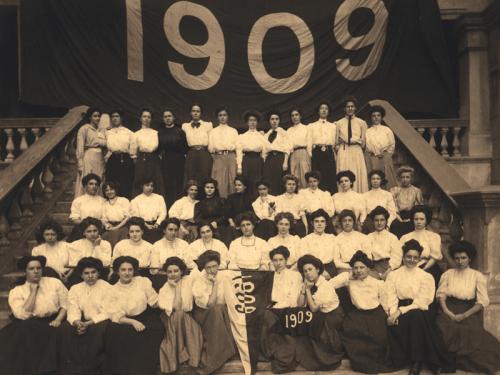
1886
Josephine Louise Newcomb gave $100,000 (worth roughly $2.7 million today) to the Tulane Board of Administrators in memory of her daughter, Harriott Sophie Newcomb, who died of diphtheria at the age of fifteen. Mrs. Newcomb’s vision was to create a place that “would go on year by year doing good. Such a memorial ... [remains] better than statues or monuments.” This gift, and others that would come following her passing in 1901, established the first degree-granting coordinate college for women in the United States.
1895
Clara Gregory Baer, chair of the Newcomb College Department of Physical Education, published “Basketball Rules for Women and Girls,” in which she described two shots, the one-handed and the jump shot, which were not adopted in men’s basketball until 1936. She also invented and marketed a game called “Newcomb Ball,” and became an advocate in securing employment for Newcomb graduates in local schools. Clara Baer, and later Florence Smith, another Physical Education faculty member, inaugurated athletic activities such as Field Day, class teams, gymnastics classes, and rope climbing, which brought Newcomb attention within the New Orleans community and prestige among women’s colleges.
1895-1940
The Newcomb Pottery grew out of the early influence of art classes of the 1884 World Cotton Exposition. Julia Ward Howe headed the Women’s Department and encouraged women to join the arts and crafts movement. Faculty Ellsworth and William Woodward, Gertrude Roberts Smith, and Mary G. Sheerer felt an arts education should serve more than aesthetic purposes and encouraged the education of women as designers and producers. Students and graduates of Newcomb’s art program would learn skills with income-producing potential. Josephine Louise Newcomb’s original donation specifying an education that looked to the “practical side of life” also favored the development of an “industrial” art program. The Newcomb Pottery was an experiment, or model industry, to provide employment for women at a time and in a milieu where few opportunities existed.
1914-1945
Newcomb women’s participation in civic affairs and the workforce expanded during both world wars, as they organized for political causes, served in public office, and worked in jobs that had previously belonged almost exclusively to men. After the wars, many women returned to their homes and assumed more traditional family roles.
1918
Newcomb moved to the Broadway Street campus in 1918, with custom-designed classrooms and art buildings, a larger dormitory that included a resident Counselor-to-Women, and increased academic rigor. Sororities and other student clubs began to acquire permanent places on campus for their meetings. Acorns from the original oak trees of the Washington Avenue campus were transplanted to the new campus; traditions such as class ring ceremonies, the wearing of caps and gowns, May Day, and other rituals, continued.
1919-2006
From its inception, Newcomb has had many beloved leaders, beginning with Brandt V.B. Dixon, the first and only president of Newcomb College. Dixon led the college until 1919 when the Board of Administrators replaced him with a series of deans. It appointed the first woman dean, Anna Many (NC ’09) in 1951, following a long tenure as a professor in the mathematics department. Many alumnae fondly remember Dean Cynthia Lowenthal, who led the college from 2000-2006.
1963
Shortly after New Orleans public schools desegregated, the city’s most prestigious institution of higher learning reconsidered its historic racial exclusion. Tulane University had been a segregated institution for its 129-year history until February 1963, when eleven black students enrolled. They arrived after Barbara Guillory Thompson and Pearlie Elloie brought a lawsuit against the university arguing that Tulane’s involvement with the state precluded its private status. While appealing the decision in favor of Tulane, the board voted to admit black students. In 1964, Deidre Dumas Labat (NC’66) was the first black woman enrolled at Newcomb College.
1972
In June 1972, President Nixon signed into law Title IX of the Education Amendments of 1972. Title IX is a comprehensive federal law that prohibits discrimination on the basis of sex in any federally funded education program or activity. During this same period, men and women undergraduates began taking courses with one another, and single-sex classes ended. In 1976, Tulane created its first varsity athletic scholarship for women.
1987
In keeping with the national trend of co-education, the faculties of Newcomb College and the College of Arts and Sciences merged, creating unified academic departments. To oversee the various activities that promote the education of women, the Tulane Board of Administrators established the Newcomb Foundation and outlined the existence of a body of faculty members, Newcomb Fellows, to act in support of the College’s mission.
2005
Newcomb students and alumnae aided in the recovery following Hurricane Katrina. After the levee breach and the subsequent flooding of the city brought massive losses to the campus, the University merged the two undergraduate colleges of liberal arts and sciences. It created both Newcomb-Tulane College, the gateway for all undergraduates, and the School of Science and Engineering. The diplomas of women students in arts and sciences used to read Newcomb College of Tulane University; the diplomas of all undergraduates now read Newcomb-Tulane College of Tulane University.
Today
Newcomb Institute is a groundbreaking academic center at the leading edge of local to global gender equity research, and building the next generation of gender equity focused scholars, leaders, and professionals via focused training opportunities for undergraduate students at Tulane University.
Newcomb alumnae participate with the life of the Institute and the University through a variety of events and volunteer opportunities and support today’s undergraduate students through mentorship programs, fundraising initiatives, and more.
